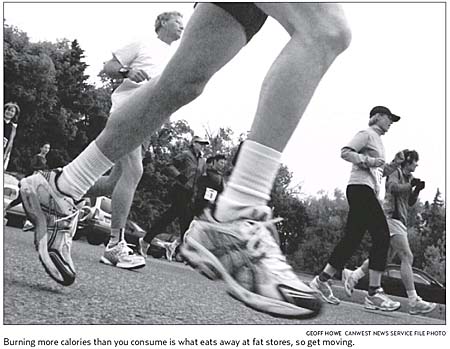|
Calories to burn
by Jill Barker
The Gazette, Tuesday, June 9, 2009
A NEW STUDY disputes the post-exercise ‘after-burn’ theory, but working up a sweat is still one of the best things for your health |
There is a long-held belief that exercise can turn you into a fat-burning machine. The idea is based on the suggestion that fat burning occurs not just during exercise but also long after your workout is over. That post-exercise burn, so goes the theory, is instrumental in losing unwanted weight.
As it turns out, however, like so many headlines touting weight-loss miracles, this one is more myth than fact.
“To our surprise, we have found that exercise has little, if any, effect on 24-hour fat oxidation (burning),” declared Edward Melanson, an exercise physiologist from the University of Colorado and lead author in an article titled Exercise Improves Fat Metabolism in Muscle but Does Not Increase 24-h Fat Oxidation (Exercise and Sport Sciences Review, April 2009).
Melanson used an interesting design to challenge the long-held belief that exercise enhances fat burning. Sixty-five candidates of varying fitness level and girth (well trained and sedentary, lean and obese) all cycled at varied intensities until they burned 400 calories, after which they were monitored for 24 hours – a period that exceeds most other studies by several hours. All were monitored in closed quarters and were able to eat during the 24-hour period. None posted results that suggested enhanced fat burning during or after their workouts.
The study has caused quite a stir among fitness experts who now have to think twice before suggesting that exercise boosts metabolism in the short or long term.
Before putting your feet up in protest, keep in mind that this study in no way diminishes the value of regular exercise. Working up a sweat is still one of the best things you can do for your health. And regardless of the amount of fat you may or may not burn post-workout, there’s no denying that a moving body burns more calories per minute than a sedentary one.
The message about fat burning has always been confusing for the average exerciser wanting to get rid of a little extra baggage. The oftentouted premise that certain forms of exercise or that working out at a certain intensity can selectively burn off unwanted fat stores is without scientific merit.
In fact, our fixation on fat burning is misguided. When it comes to achieving your weight loss goals, any calorie you burn is a good one – whether it be in the form of fat, carbohydrate or protein. As long as you burn more calories than you consume, the weight will come off.
As for the much ballyhooed postexercise after-burn, well, let’s just say the number of calories burned is less than impressive.
According to Pascal Imbreault, associate professor at Ottawa University’s School of Human Kinetics, any exercise-related after-burn usually runs its course within 15 to 35 minutes of completing a workout. And while the actual number of calories expended during this time varies according to exercise intensity, duration and the body weight of the exerciser, he describes the resulting calorie burn to be “very minimal.”
Imbreault suggests that exercise doesn’t do much to crank up your metabolism over the long term either, despite what the headlines in fitness magazines claim.
“Exercise is not that powerful,” he said.
Also included in the list of overstated metabolic benefits is the popular belief that adding more muscle to your frame will increase the number of calories you burn at rest.
The idea that muscle is more metabolically active than fat, and therefore burns more calories, is not a fair representation of what really happens, Imbreault says. He claims that active muscle demands far more calories to maintain than muscle that isn’t in use. He also suggests that during periods of rest, muscle and fat probably demand roughly the same amount of calories to sustain themselves.
Does that mean all those hours in the weight room were for naught? Relax. The benefits of added muscle don’t diminish because you miscalculated how much they contribute toward your daily caloric expenditure. Maintaining and building muscle mass still reduces the risk of injury, makes the accomplishment of daily tasks easier, improves athletic performance and helps you rock a T-shirt.
As for exercise and its role in weight loss, the message couldn’t be easier to understand. Use exercise to increase the number of calories you burn. Make smart food choices and trim down your portions to reduce the number of calories you consume. Do that more days than not, and you’ll become a calorie-burning machine that slowly but steadily loses excess body weight.
As for fat burning, don’t confuse it with the goal of trying to get rid of those love handles. Chipping away at excess flab doesn’t require you to selectively burn fat over carbohydrates or protein. Creating a negative energy balance (burning more calories than you consume) is what eats away at fat stores, so get moving. Every calorie burned is one less stored – on the hips or anywhere else.
© The Gazette
|


